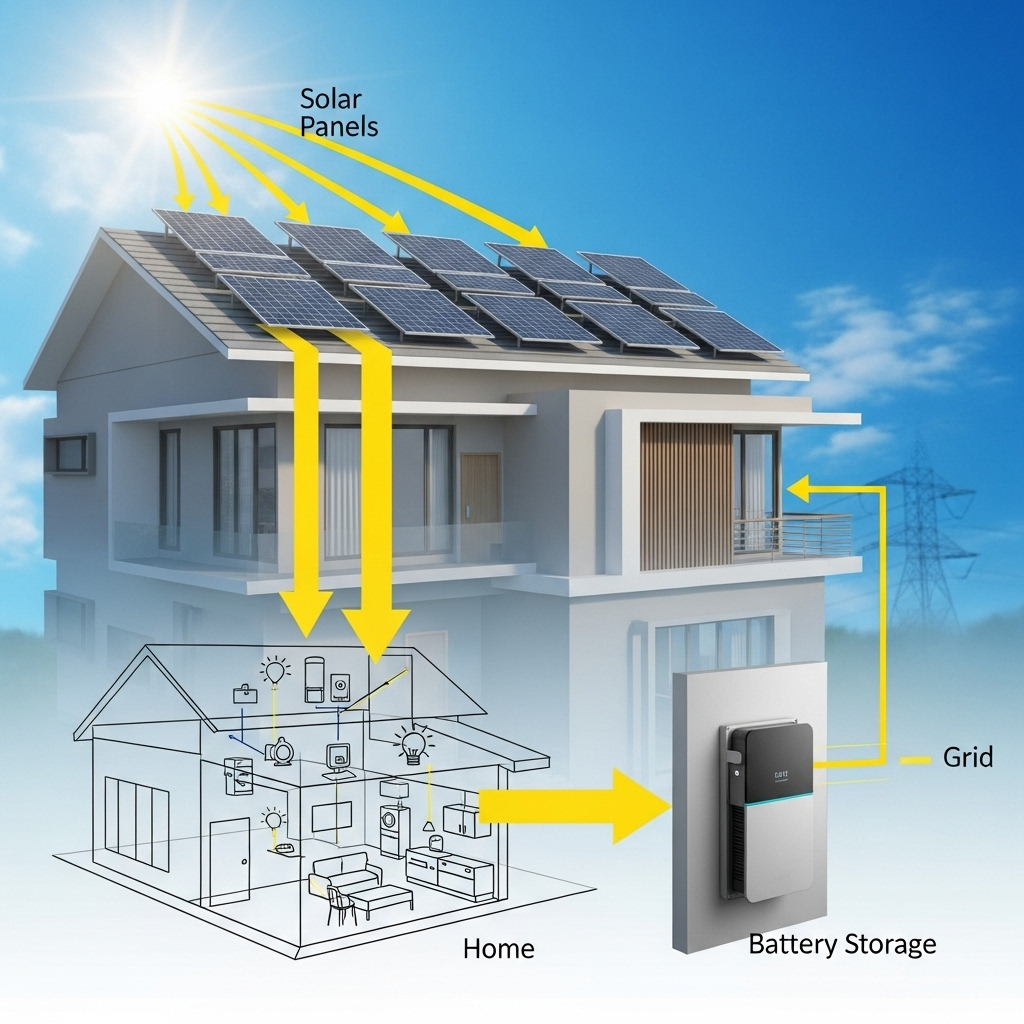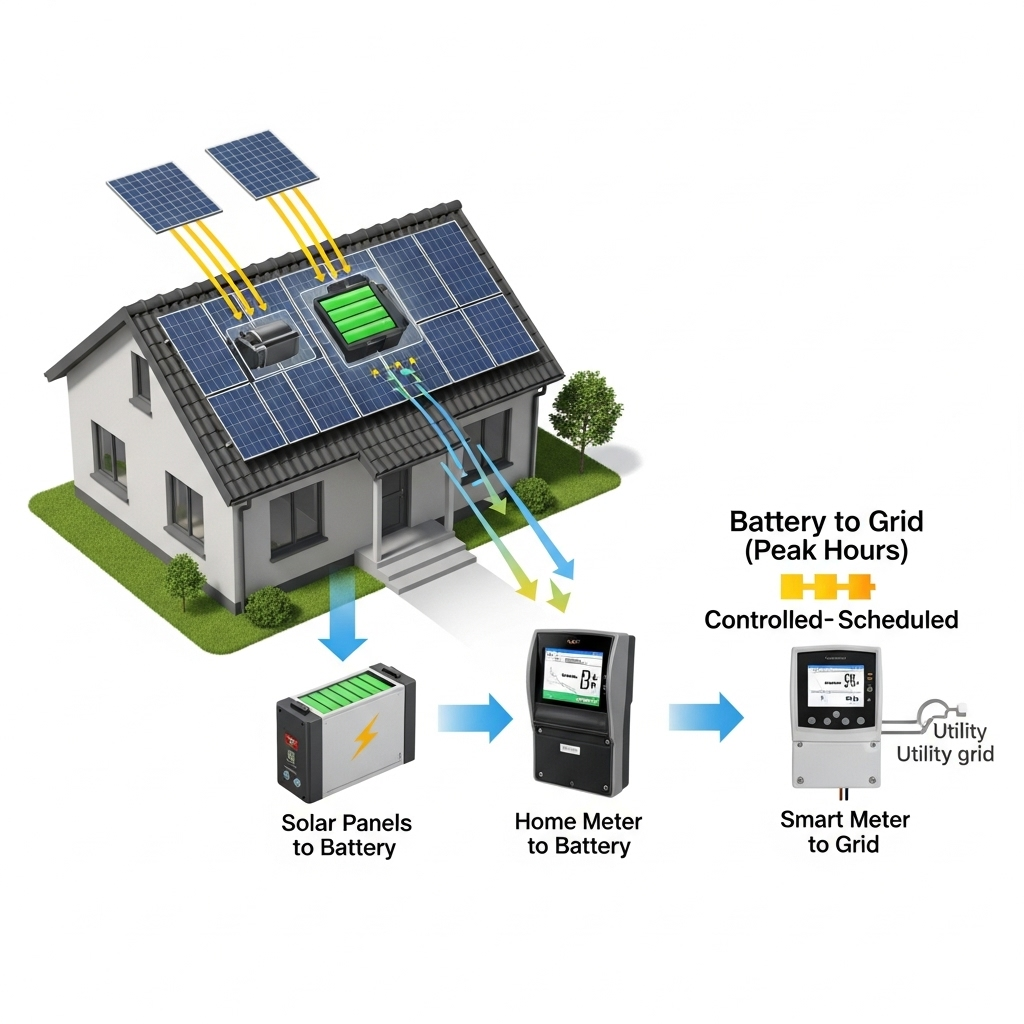As solar energy adoption grows, the way homeowners are compensated for the excess power they send to the grid is changing. Simple one-to-one credit systems are giving way to more sophisticated structures. These new export rate designs better reflect the value of solar power and create new opportunities for owners of solar and energy storage systems (ESS). Understanding these models is key to maximizing your system’s financial payback and contributing to a more stable, efficient grid.
From Traditional Credits to Value-Based Compensation
The conversation around solar export compensation has evolved significantly. Early programs were designed for simplicity to encourage adoption, but modern grids require more dynamic solutions. This shift opens the door for solar-plus-storage owners to play a more active and profitable role in the energy market.
The Original Model: Net Energy Metering (NEM)
Net metering was the foundational policy for residential solar. It functions like rollover minutes on a phone plan. For every kilowatt-hour (kWh) of solar energy you export to the grid, you receive a credit for one kWh to use later. This 1:1 exchange is simple and effective. However, as solar adoption has increased, some argue this model doesn't accurately reflect the costs of maintaining the grid. A report from the International Energy Agency, Unlocking the Economic Potential of Rooftop Solar PV in India, highlights the challenge of balancing interests between consumers and utilities, a key driver for rate reform.
The Next Step: Net Billing and Value of Solar
Net billing, or a 'buy-all, sell-all' approach, unbundles the price of electricity. You buy all the electricity you consume from the utility at the standard retail rate. Separately, you sell all the electricity your solar system generates to the utility at an 'export' or 'avoided cost' rate. This rate is often lower than the retail rate but can be structured to reward you for providing power when the grid needs it most. This approach, sometimes part of a Value of Solar Tariff (VOST), attempts to calculate the true value of distributed solar generation, including avoided energy, transmission, and environmental costs.
7 Modern Export Rate Designs for Solar and Storage
Utilities are implementing a variety of export compensation schemes. Each one offers different incentives and works best with specific system configurations, especially those including battery storage.
1. Time-of-Use (TOU) Export Rates
With TOU rates, the price of electricity changes throughout the day. You earn a higher credit for exporting power during 'peak' hours (typically late afternoon and early evening) when demand is high. An ESS is invaluable here. You can store solar energy generated during midday low-rate periods and export it during the high-rate evening peak, significantly boosting your revenue.
2. Value of Solar Tariff (VOST)
A VOST calculates a specific compensation rate based on an administrative assessment of solar's benefits to the grid. This can include the avoided cost of fuel, reduced need for new power plants and transmission lines, and environmental benefits. It is a comprehensive but complex approach to fairly price solar exports.
3. Buy-All, Sell-All (Gross Metering)
As mentioned earlier, this structure completely separates your consumption from your generation. You are paid a specific rate for every kWh your system produces, and you pay the standard retail rate for every kWh you use. It simplifies accounting but removes the direct financial benefit of self-consuming your solar power.
4. Dynamic Export Rates
This is the most advanced model. Export rates fluctuate in near real-time based on wholesale market prices and grid conditions. It offers the most accurate price signals but requires sophisticated smart inverters and control systems that can react automatically to price changes. Homeowners with battery storage can program their systems to sell high and buy low, acting like active participants in the energy market.
5. Export Rate Adders for Storage
Some programs offer a 'kicker' or bonus payment for energy exported from a battery. This recognizes the 'dispatchable' nature of stored energy—its ability to be deployed on demand. This adder makes the financial case for adding a battery to your solar PV system even stronger, as it directly rewards the grid-stabilizing capability of your ESS.
6. Location-Based Compensation (L-DER)
Where your system is located on the grid matters. In areas with grid congestion or aging infrastructure, distributed generation is more valuable. Location-based rates, also known as Locational Marginal Pricing for Distributed Energy Resources (LMP-DER), pay a premium for solar exports in these specific zones, incentivizing development where it provides the most grid relief.
7. Avoided Cost of Service Rates
This model bases compensation on the specific utility costs that a solar-ESS system helps the utility avoid. It's a granular approach that looks at how your system reduces the need for generation capacity, line maintenance, and other operational expenses. The calculation can be complex, but it aims to be one of the most equitable methods.
| Rate Design | Simplicity | Payback Potential with ESS | Grid Benefit |
|---|---|---|---|
| Net Metering (NEM) | High | Moderate | Low |
| Time-of-Use (TOU) Export | Moderate | High | High |
| Value of Solar Tariff (VOST) | Low | Moderate to High | High |
| Buy-All, Sell-All | High | Moderate | Moderate |
Unlocking Value with Smart System Management
These advanced rate designs are only as good as your ability to use them. A solar-only system is passive; it exports power whenever the sun is shining. A solar-plus-storage system gives you control.
The Central Role of Energy Storage
An Energy Storage System, often using reliable and high-performance LiFePO4 batteries, is the key to unlocking the full potential of modern export rates. It transforms your intermittent solar resource into a dispatchable asset. You can choose when to self-consume, when to store, and when to sell your energy to the grid for the highest possible price. This flexibility is what turns your home into a mini power plant that interacts intelligently with the grid.
Smart Technology and Interconnection Rules
To capitalize on these opportunities, you need smart inverters and energy management software that can automate decisions based on utility rate structures. Furthermore, outdated regulations can be a barrier. As noted in a U.S. Department of Energy success story, improving interconnection for solar and battery storage is critical. The BATRIES toolkit mentioned in the article helps regulators update rules to recognize the flexible capabilities of storage, allowing for operating schedules that can prevent costly grid upgrades and speed up project approvals. To fully leverage these rates, you need a deep understanding of your system's capabilities. A detailed look at solar storage performance metrics can help you configure your system for optimal financial returns.
A More Resilient and Interactive Grid
These new rate designs are not just about homeowner compensation; they are about building a better grid. By sending the right price signals, utilities can encourage behavior that supports grid stability and defers expensive infrastructure investments.
Enhancing Grid Stability
When thousands of homes use batteries to absorb midday solar oversupply and discharge it during evening peaks, they collectively act as a massive virtual power plant. This smooths the 'duck curve' of net demand, reducing stress on central power plants. The U.S. Department of Energy's SunShot initiative has long supported research into grid integration solutions, recognizing that enabling solar to provide power at all hours is a primary challenge.
Fair Cost Allocation
A major utility concern with simple net metering is that solar owners may not pay their fair share for grid upkeep. Value-based rates are designed to address this by aligning compensation with the actual value provided. This creates a more sustainable and equitable framework for all customers, both with and without solar. As the World Energy Investment 2023 report from the IEA shows, policies like the U.S. Inflation Reduction Act are providing major boosts to renewables, making the need for robust and fair rate structures more urgent than ever.
Shaping Your Energy Future
The transition from simple net metering to dynamic, value-based export compensation marks a new chapter for residential energy. While these structures introduce complexity, they also create powerful incentives for investing in solar-plus-storage systems. By understanding these designs, you can make informed decisions that lower your energy bills, accelerate your return on investment, and support a cleaner, more resilient electrical grid for your community.
Disclaimer: This information is for educational purposes only. Export rate designs vary significantly by state and utility. Consult with a local solar professional and your utility provider to understand the specific compensation rules and financial incentives available in your area. This is not financial or legal advice.
Frequently Asked Questions
What is the main difference between net metering and net billing?
Net Metering
Net metering is a 1-for-1 credit system. The excess electricity you send to the grid is credited to your account at the full retail rate, effectively spinning your meter backward. You use these credits when you draw power from the grid at night or on cloudy days.
Net Billing
Net billing separates the rates. You are paid for your exported electricity at a specific 'export rate,' which is often based on the utility's avoided cost. You still pay the full retail rate for any electricity you buy from the grid. This often results in a lower compensation rate than traditional net metering.
How does an energy storage system increase my solar payback?
By Maximizing Self-Consumption and Leveraging TOU Rates
A battery allows you to store excess solar energy produced during the day instead of exporting it for a low credit. You can then use this stored energy in the evening, avoiding the need to buy expensive peak-rate electricity from the grid. Under Time-of-Use (TOU) export rates, you can also choose to export this stored energy during peak hours to earn a much higher compensation rate, accelerating your system's payback period.
Are these advanced export rates available everywhere?
Availability Varies by Location
No, the availability of these rate designs is highly dependent on your state and local utility company. While traditional net metering is still common, many regions are transitioning to net billing, TOU rates, or pilot programs for more advanced designs like VOST. It is crucial to check your local utility's current policies and tariffs for distributed generation customers.





Leave a comment
All comments are moderated before being published.
This site is protected by hCaptcha and the hCaptcha Privacy Policy and Terms of Service apply.